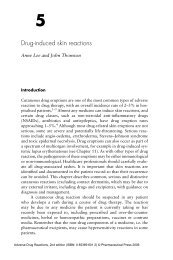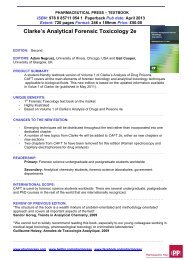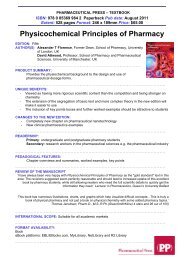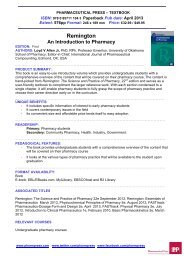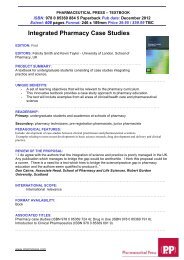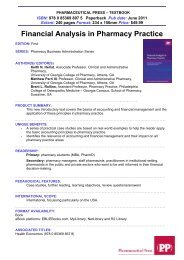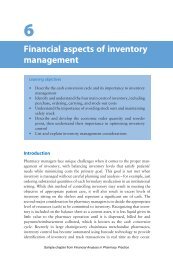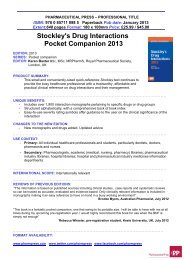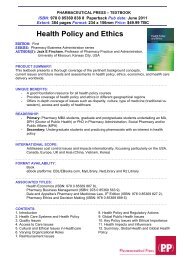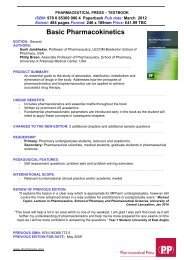6 Extravascular routes of drug administration
6 Extravascular routes of drug administration
6 Extravascular routes of drug administration
Create successful ePaper yourself
Turn your PDF publications into a flip-book with our unique Google optimized e-Paper software.
120 Basic Pharmacokinetics<br />
C p (mg mL –1 )<br />
t = 0<br />
(C p ) max<br />
t max<br />
Time (h)<br />
C p (mg mL –1 )<br />
t = 0<br />
(C p ) max<br />
?<br />
Time (h)<br />
Figure 6.18 Rectilinear plots <strong>of</strong> plasma concentration (Cp) against time following the <strong>administration</strong> <strong>of</strong> a <strong>drug</strong> via extravascular<br />
route. The accuracy <strong>of</strong> the estimation <strong>of</strong> the peak plasma concentration (Cp)max depends upon having sufficient data points (full<br />
points) to identify the time <strong>of</strong> peak concentration (tmax).<br />
Absorption<br />
phase<br />
C p (ng mL –1 )<br />
I =<br />
t max<br />
K a FX 0<br />
V (K a – K )<br />
Time (h)<br />
Elimination phase<br />
Figure 6.19 Semilogarithmic plot <strong>of</strong> plasma concentration (Cp) against time following the <strong>administration</strong> <strong>of</strong> a <strong>drug</strong> via the<br />
extravascular route, showing the intercept (I) and the time <strong>of</strong> peak concentration (tmax). Other abbreviations as in Fig. 6.6.<br />
We present, without pro<strong>of</strong>, a simpler equation for<br />
(Cp)max:<br />
where<br />
(Cp)max = FX0<br />
V e−Ktmax (6.35)<br />
FX0<br />
V =<br />
Ka − K<br />
Ka<br />
<br />
(I)<br />
and I is the intercept <strong>of</strong> the plasma concentration<br />
versus time pr<strong>of</strong>ile for a single dose.<br />
The peak plasma concentration, like any other<br />
concentration parameter, is directly proportional to<br />
the mass <strong>of</strong> <strong>drug</strong> reaching the general circulation<br />
or to the administered dose. This occurs when the<br />
Sample chapter for Basic Pharmacokinetics 2nd edition<br />
first-order process and passive diffusion are operative<br />
(another example <strong>of</strong> linear pharmacokinetics).<br />
6.11 Some general comments<br />
1 The elimination rate constant, the elimination<br />
half life, and the apparent volume <strong>of</strong> distribution<br />
are constant for a particular <strong>drug</strong> administered<br />
to a particular patient, regardless <strong>of</strong> the route <strong>of</strong><br />
<strong>administration</strong> and the dose administered.<br />
2 Therefore, it is a common practice to use values<br />
<strong>of</strong> the elimination rate constant, the elimination<br />
half life and the apparent volume <strong>of</strong>



